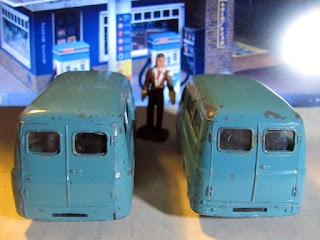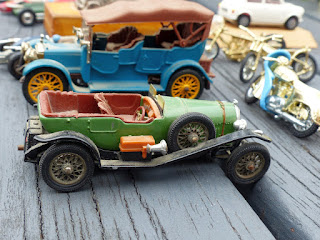It's funny what can happen when you're in a hotel car park in Towcester. I had arranged to meet a young Mr Wilford, recently flown in from New Zealand to help his mother with some things, whose father had been a Designer at Corgi and whose grandfather had been Percy Wilford, one of Corgi's Chief Designers. He said he had a few odd items lying around at his mother's house and wondered if I could advise him.
First of all he gets out a box of pretty tedious-looking Corgi Classics and they're all familiar apart from one that catches my eye. Yes, it's the 9022 Daimler 1910 38 'Available Later' in the Corgi Catalogue. It's missing a steering wheel and dashboard but looked otherwise finished and ready to put on the market.
I took another look also at a Bentley 1927 3½ litre. Initially the silver horn had caught my eye but then I noticed the very detailed dashboard and steering wheel! Marvellous work by someone there.
There are also some motorcycles that I do not recognise but which seem to be Corgi proptotypes. Perhaps there might have been a series of bikes in someone's plans at the time?
In another box were some Whizzwheel models and amongst them some strangely coloured Alfa Romeo P33s.
I knew this car in white rather than metallic light pink, blue or rhododendron!
The Porsche 911 Targa also looked different. The wheels. Now they suited the car so much better than the ubiquitous Whizzwheels it came out with. I also know the car with a black interior for this shade, not the bright orange.
Turning the cars over, revealed an explanation.
These were all samples, with bases screwed on rather than riveted. How much easier our lives would be now had Corgi used screws throughout!
Now, imagine the scene. You'll see that we were using a table outside the hotel and had Corgi Toys spread here and there. An older chap walks by with his wife and remarks something to the effect of 'That's a nice display. I recognise some of those.'
We tell him who we are and what we're doing and he tells us that he also worked at Corgi Toys in Northampton. Mr Hancock was another Designer there. Quite an extraordinary coincidence. he proceeds to tell the young Mr Wilford that he is very much like his father, who Mr Hancock had known well and worked with in the later 1960s and he tells us that his picture is in The Great Book Of Corgi. and the young Mr. Wilford just happens to have that in the boot of his car! After some shuffling through the pages, Mr Hancock finds himself in one of the pictures again.
Mr Hancock did say that his specialist area was 'wheels'. Apparently he had the best set of compasses there at the time. I did briefly wonder whether we had met the man responsible for Whizzwheels but I decided not to pursue that subject. Another day, perhaps.
We move on to look at another box. This one contains gold-plated models. The Batmobile and Jaguar show signs of tarnishing that I presume would imply that it's not real gold plating but some other compound that looks nice and shiny and gold but reacts more to the air.
Looking much brighter are a Ferrari Berlinetta, a Rover 2000 (252 type) and Jaguar Mk X.
These show no signs of tarnishing and are all pretty much immaculate, just in need of a careful clean. there is also a lovely Land Rover (438 type) with some nice black paint detailing on top of the plating.
I believe that these gold-plated items would have been examples of maybe a dozen or so made as gifts for important visitors or people Corgi executives visited. These are just some that were not used or, perhaps, were samples as many of the items gave me the impression that they came from a Samples Department which was referred to in some paperwork.
The young Mr Wilford also had piles of books and catalogues. The two Great Books Of Corgi had been signed by Marcel Van Cleemput.
A nice collection of original catalogues were there too, most pretty much as new, with Canada or New Zealand and dates written on them. again, I am assuming these were samples from a print run.
Although featured here at the end, the first thing I actually had spotted was this metallic lime green Chevrolet Camaro, the 304 edition with Whizzwheels.
The solid blue edition is scarce as it is, so to find another colour was a great surprise and, for me, one of the most exciting items there.
For others it may be the gold-plated Batmobile or the never- issued Daimler but I think my personal favourite out of all is the gold-plated Rover 2000. It's just the standard 252 car, plated. Wonderful.
All in all, a pleasant and fascinating afternoon with the remarkable coincidence of a chap wandering in to a hotel in Towcester meeting someone from New Zealand who had his photo in a book in his boot! But I find my life is full of surprises anyway.
Now, I need help from you people out there as to what that plating may or may not be. I need to suggest to the young Mr Wilford how we should go about disposing or these items, or not, as the case may be. Whilst I cannot say that all or any of these will be available to purchase in the near future or, indeed, that I will get the task of arranging identification and sale, if you do wish to express an interest in any of them or are aware of similar items that had been sold in the past, then do please get in touch.
I am confident that, with a bit of help, I will be able to make as good a job of finding good new homes at worthwhile prices as the big auction houses.











































